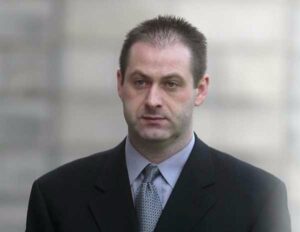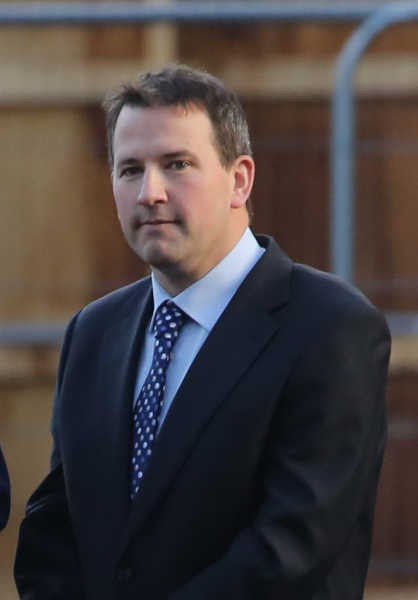There’s no nastier business than murder, nothing more callous or terrifying. Murder is pervasive; it exists in every society and permeates every generation. Ireland is no exception. Courts News Ireland brings you 5 of the most notorious Irish murder cases:
#5 G.U.B.U
The infamous term GUBU – grotesque, unbelievable, bizarre and unprecedented – is in a unique category of acronyms, in that it is both unforgettable and wiltingly accurate.
It was paraphrased in 1982 by Conor Cruise O’Brien from a comment by the Taoiseach Charles Haughey after Dublin socialite, dicky bow aficionado and double murderer Malcolm McArthur was arrested in the home of the then Attorney General, Paddy Connolly.
Having spent the last of his inheritance on maintaining his lavish lifestyle, in July 1982 Malcolm McArthur left his partner and his son while on vacation in Tenerife and returned to Ireland to fund his expensive tastes through crime.
In need of a car, McArthur took a hammer to the Phoenix Park and spotted Bridie Gargan, a nurse, sunbathing near her vehicle. He then approached the 27-year-old woman, shouted at her and grabbed her as she ran towards her car, bludgeoning her repeatedly and ferociously.
An onlooker tried to chase McArthur away, but McArthur threatened him and pushed Bridie into the back of her car before taking off. Spotted by an ambulance driver, who confused McArthur for a doctor because of the windscreen sticker Bridie had for her work in St James Hospital- McArthur was escorted to the hospital where he abandoned Bridie and her vehicle.
On the run, he called to farmer, Donal Dunne, in Edenderry, Offaly, three days later. He planned to buy Donal’s shotgun but instead, while he was inspecting it, turned it on the unsupecting farmer and shot him dead. McArthur then stole his car and returned to Dublin.
On August 13th, McArthur was arrested in an apartment owned by the Attorney General Paddy Connolly. It later emerged that just days after the murders McArthur had attended the all-Ireland hurling semi-final between Galway and Kilkenny at Croke Park with Connolly, where they sat in a VIP box as gardai scoured the country.
McArthur pleaded guilty to the murder of Bridie Gargan, sparing the State the embarrassment of a trial, and was sentenced to life in jail. He was released from an open prison in 2012.
#4 A Woman a Week
In 1975 English drifters, John Shaw and Geoffrey Evans, arrived on Irish soil with the intention of murdering and raping a woman a week.
Both in their 30s and wanted in connection with three British rape cases, the pair slipped under Ireland’s skin and began to fund their murder spree by carrying out house burglaries across the country. Evans, who was said to be the brains, and Shaw, the brawn, were caught the next year in Cork and jailed for two years for the break-ins.
Freed 18 months later on bail, the men escaped British authorities again and set out to accomplish what they came to Ireland for. Driving to Brittas Bay in Co Wicklow in late August 1976, they laid eyes on Elizabeth Plunkett, a 23-year-old clerk from Dublin.
The men offered her a ride home but took an unexpected turn and drove her up to Castletymon Woods, Dublin, where they repeatedly raped her. Evans then ordered Shaw to kill Elizabeth. Shaw choked the young woman with the sleeve of his shirt before dumping her weighed-down body in the sea.
Moving on and arriving in Galway on September 10th, Shaw and Evans stole a Ford Cortina and drove to Castlebar, Mayo where they abducted, beat and raped local chef Mary Duffy, aged 24.
Shaw then suffocated her by holding a cushion over her head and threw her body into a lake. Early on September 26th, Garda spotted the stolen Cortina and Evans and Shaw were taken into custody.
They confessed to the murder and rape of both women and were sentenced to life in jail, where they became Ireland’s longest serving prisoners.
#3 The Grangegorman Killings
On the morning of March 7th 1997, Sylvia Shields and Mary Callinan were found dead in No.1 Orchard View, Grangegorman, Dublin 7; a terraced house used to provide accommodation for outpatients of St Brendan’s Psychiatric Hospital.
The two women had been partially undressed, stabbed numerous times and their throats and faces had been cut. One of the women’s genitals had also been mutilated to a level never encountered in an Irish murder investigation. Neither of the women had been raped.
Due to the brutality of the murder, the Gardai made an appeal on Crimeline, which led them to Dean Lyons. Addicted to heroin and drifting in and out of homelessness at the time, Lyons confessed to the crimes after six hours of garda interviews and was charged with the murder of Mary Callinan.
The Gardai’s new accused, however, was borderline intellectually disabled and had a history of having attended a special school.
Subsequent psychological testing established that Dean Lyons was abnormally and exceptionally suggestible and the had an abnormal tendency to give in to leading questions. Lyons had a long track record of making up stories that were wholly false but convincing in the telling.
His family had also warned gardai that Dean Lyons was a compulsive liar. Lyons himself later claimed he was suffering from heroin withdrawal and that his prescribed methadone was withheld until he had made a video-taped confession.
The validity of Lyons’ confession was under scrutiny after numerous pieces of information he initially gave were not consistent with the crime. There was also another shocking revelation that cast doubt over his guilt.
Murderer Mark Nash had stabbed Carl Doyle and Catherine Doyle to death in Roscommon three months after the Grangegorman Killings. Arrested and charged with murder of Carl and Catharine, Nash admitted to the Grangegorman stabbings, but later retracted his statement.
This confession from Nash then led to a review of both Lyons’ and Nash’s statements. The charges against Dean Lyons were dropped in April 1998. He died the day after he was released from a Manchester prison, where he had been serving another sentence, in 2000.
In 2015 Nash went on trial for the murder of Sylvia Shields and Mary Callinan for the second time, having already been imprisoned since 1998 for the Roscommon double murder. He was found guilty and handed down another life sentence. With four murders to his name, Nash is one of Ireland’s most prolific killers.
#2 The rise and fall of Colin Whelan
Colin Whelan had vowed to love and cherish his wife, Mary Gough. What Mary didn’t know before saying her vows to the man she had loved for almost a decade, was that Whelan had already doubled their life insurance policy, researched numerous ways to kill her and boasted about his impending fortune on an online dating service.
Six months later, Mary was found dead at the bottom of the staircase in her Co Meath home. Whelan had phoned for the ambulance, claiming that she had fallen.
Upon arriving at Beaumount Hospital questions were raised about the cause of death, as the doctors who tried to resuscitate Mary noticed she was cold to the touch and had marks on her neck and chest that suggested she had not fallen down the stairs.
Later that day, Dr Marie Cassidy, the State Pathologist, confirmed the suspicions of Gardai and reported that Mary Gough had in fact died of asphyxiation involving a ligature. She had been strangled to death with the belt from her dressing gown.
Whelan was charged with her murder but seven months before his trial in 2003, in a Reggie Perrin-style twist, he faked his own death.
Whelan abandoned his car at Howth Head, Dublin and escaped to Spain with a false passport in the name of Martin Sweeney. There he had a large circle of friends, a girlfriend and a budding career. He was vetted by the Spanish police who issued him with a National Identity Card in the name of Martin Sweeney.
Life was good for Whelan, who worked in a bar. However, his cover was blown when Irish tourists recognised him and reported his whereabouts to the Gardai. He was extradited in 2004 and sentenced to life in 2005.
#1 Master and Slave
A relationship unlike most others began between two Dubliners in 2007, when Graham Dwyer and Elaine O’Hara set themselves one boundary- Master and Slave.
Having met online at alt.com, a website for people with interests in bondage, domination, submission and masochism, the pair explored their own limits as Elaine played the role of slave and Dwyer acted as her master, giving her orders and punishing her.
Dwyer asked Elaine, who suffered from depression and had been admitted into hospital on numerous occasions due to her mental health, to make a promise at the beginning of the sordid relationship: if she wanted to die, she would let Dwyer kill her.
“If you ever want to die, promise me I can do it,” he wrote to her.
Over the years, their relationship and experimenting reached sinister heights. Elaine lost her long-term psychiatrist and was admitted into hospital again. She cut contact with Dwyer until her release, when he contacted her from a new mobile phone that he had bought with a false name and address.
Dwyer, who worked as an architect, constantly messaged Elaine. In their sexual life, he insisted on cutting her with a knife and each time was more and more extreme. Elaine became frightened and began to distance herself from him.
By August 22 2012, hours after she was discharged from a mental hospital, Elaine O’Hara was nervous but still left her apartment for the last time, as a final order from her master. She met Dwyer in the evening and he brought her up Killakee Mountain, Dublin, where he stabbed her to death for his sexual gratification.
Dwyer disposed of her belongings to make it look like a suicide and had arranged for Elaine to leave her car at the coastal graveyard where her mother was buried in Shanganagh, South Dublin. His plan almost worked and, in the words of the State prosecutor, it was ‘very nearly the perfect murder’.
Just over a year after Elaine was last seen alive, a dog uncovered her skeletal remains in the mountains at Killakee on Dwyer’s 41st birthday, Friday 13th September 2013. It was three days after her keys had been found in the almost-dry Vartry Reservoir in Roundwood, Co. Wicklow.
They were found after the water level had dropped from 20 feet to less than two feet following the particularly warm summer of 2013.
After a two-month trial, a jury found Dwyer guilty of murdering Elaine O’Hara and he is currently serving a life sentence







